Interpreting a Prashna kundali in Prashna Astrology is both an art and a science. While the fundamentals must be mastered, true wisdom comes through intuition developed with dedicated practice. This article outlines some of the most important techniques used in Prashna Jyotish to read the chart effectively and make accurate predictions.
1. The Role of the Lagna (Ascendant) in Interpretation
The Lagna is the heart of the Prashna chart. The strength, dignity, and placement of the Lagna lord indicate the overall possibility of getting a clear and accurate answer. A strong Lagna lord or benefic planets in the Lagna itself show a truthful question and that the querent is genuinely seeking guidance.
If malefics afflict the Lagna or its lord, the question may be insincere, confusing, or the querent may be hiding the real issue. A retrograde or combust Lagna lord may indicate doubts or changes in the mind.
Example: If a person asks about a job opportunity and the Lagna is Virgo with Mercury combust in the 5th house, it shows the person is overthinking, anxious, and unclear about their goals.
2. Use of Arudha Lagna in Prashna
Arudha Lagna is important in understanding the perception of the question or how the situation appears externally. Comparing the Lagna and Arudha Lagna gives clarity about the real issue vs. the perceived issue. For example, if the Lagna lord is strong but Arudha Lagna is afflicted, the reality is fine, but the querent is stressed.
3. Moon’s Position and the Chandra Lagna
Moon reflects the emotional state of the querent and helps judge the current mental environment. Always check which house the Moon is placed in, and whether it is aspected or conjoined by benefic or malefic planets.
Example: If the Moon is in the 8th house with Saturn and Rahu, the question may be born out of fear, anxiety, or obsession.
4. House Analysis for Specific Queries
Understanding the role of houses is vital in Prashna. Here’s a brief example:
- 1st House: Querent’s mind and body
- 2nd House: Speech, wealth, family
- 3rd House: Communication, efforts, siblings
- 4th House: Home, peace, mother, property
- 5th House: Children, creativity, education
- 6th House: Health, enemies, competition
- 7th House: Marriage, business, partners
- 8th House: Hidden matters, transformations, longevity
- 9th House: Fortune, religion, dharma, father
- 10th House: Career, profession, action
- 11th House: Gains, friends, social circles
- 12th House: Loss, moksha, foreign connection, expenses
Each house must be studied with its lord, aspects, conjunctions, and any special yoga or dosha.
5. Importance of Dasha and Transit in Prashna
Though Prashna is moment-based, dasha and gochar (transits) play an auxiliary role. If the Prashna chart and current dasha or transit support each other, the prediction becomes stronger.
Example: If a person asks about marriage and the 7th lord is strong in the Prashna chart, and simultaneously their natal chart is running Venus-Moon dasha (favorable for marriage), it reinforces the prediction.
6. Use of Navamsa and Other Divisional Charts
Using Navamsa and other divisional charts can refine your judgment. A planet may appear strong in the main chart but weak in divisional charts, changing the prediction.
For Prashna, D-9 (Navamsa), D-10 (Dasamsa), and D-3 (Drekkana) are frequently used depending on the query type.
7. Yogas and Doshas in the Prashna Chart
The presence of yogas or doshas gives additional meaning. For example:
- Raj Yoga: A favorable outcome or rise in status
- Kemadruma Yoga: Lack of support or isolation
- Kala Sarpa Yoga: A Delayed or karmically entangled situation
These must be interpreted contextually.
8. Role of Retrograde, Combust, and Debilitated Planets
These factors play a crucial role in timing and clarity. Retrograde planets can show delay or return of the matter. Combust planets often show lack of clarity or ego conflict. Debilitated planets point towards weakness or failure unless there is cancellation.
9. Rahu and Ketu in Prashna Jyotish
Rahu shows obsession, illusion, sudden events, and foreign connections. Ketu indicates detachment, loss, past karma, and spiritual insights. Their placement shows karmic blocks or breakthroughs.
Example: If Rahu is in the 10th house during a job-related Prashna, the job may involve foreign connections or be driven by material obsession. If Ketu is in the 4th house, peace at home may be disturbed or spiritual detachment is developing.
Disclaimer: This information is only for educational purposes. Answering questions through Prashna Astrology requires extensive practice and deep understanding. Do not use this information to make life decisions regarding marriage, health, career, or other critical matters. If anyone chooses to use this knowledge independently, they do so at their own risk. It is always recommended to consult a trusted and experienced astrologer.








